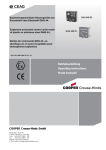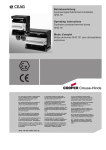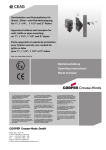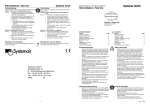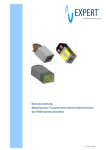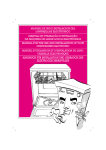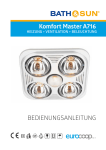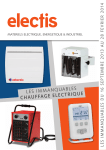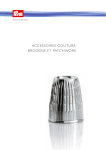Download Betriebsanleitung Operating instructions Mode d'emploi
Transcript
Explosionsgeschützte Klemmenkästen aus Kunststoff GHG 72. Explosion protected terminal boxes made of plastic GHG 72. Boites de jonction GHG 72. en plastique pour atmosphères explosives GHG 720 7001 P0001 D/E/F/ (L) Betriebsanleitung Operating instructions Mode d’emploi ĜĜ þ !!" #$%&'( #&; < !, !!"#$%&', , ,( )*+ ,,!- !%."!,,!!! )! !!"#$%&'!/! 40! ! ! = !, > %! ! ! ! !! !!"#$%&' %%!! ! !! !!"#$%&' !! ! .%! ?@ !9! ƳAnjǐ , ąąBą9, ! , !!"#$%&' B ( %00 !, 1 2!, !!"#$%&' ( ?C@ Ɨ ! Ɨ ! !Ư BƯ,Ɨ! !"#$%&'Ɨ! ƗƯBƗ( 345! 666 7 667 %.66 !!"#$%&'" +A ,ƫ B"DE",D ,ƫ ,ƫ!"!!Ī F!!#$%&'EFĪ ( '8ǼĮȞȤȡİȚĮıșİȚ9:İIJĮ(ȡĮıȘIJȦȞȠįȘȖȚȦȞȤȡȘıİ ȦȢıİĮȜȜȘȖȜȦııĮIJȘȢǼǼ9:ʌȠȡİȚȞĮȗȘIJȘșİȚĮʌȠ IJȠȞǹȞIJȚʌȡȠıȦʌȠIJȘȢ!!" #$%&'³ 5?4! , ,B! ! !%." D!,!,B.D!!" #$%&'"! ,D!,, COOPER Crouse-Hinds GmbH Neuer Weg - Nord 49 D 69412 Eberbach / Germany Fone +49 (0) 6271/806 - 500 Fax +49 (0) 6271/806 - 476 Internet: http://www.CEAG.de E-Mail: [email protected] G0E!! !HI !H1!HI! ! .I%!9 " !! !!"#$%&' G?5ą !JBá,DD D!ĊDĪ<DüD ! D DE!!"!" #$%&'!( 0%7!6 , ," 7 ! %."!K B B 6E!K%!!!" #$%&'"!! 0* B CC ! ;þ !!"#$%&'C!( 0?L5!BC !! !!"#$%&'C !( Contents: Inhalt: 1 1.1 2 3 4 5 6 6.1 6.2 6.3 6.4 6.5 6.6 7 8 9 10 Inhalt ...................................... Maßbild .................................. Technische Daten ................. Kunststoffklemmenkästen .... Sicherheitshinweise .............. Normenkonformität ............... Verwendungsbereich ............ Verwendung/ Eigenschaften ........................ Installation .............................. Montage ................................ Öffnen des Gerätes/ Elektrischer Anschluss ......... Kabel- und Leitungseinführung; Verschlussstopfen ................................... Flansch-u. Metallplatten ........ Schließen des Gerätes ......... Inbetriebnahme ..................... Instandhaltung / Wartung ..... Reparatur / Instand setzung/ Änderungen ........... Entsorgung / Wiederverwertung ............................ Strombelastungstabelle ........ 2 3-5 3 3 4 4 4 4 4 5 1 1.1 2 3 4 5 6 6.1 6.2 5 6.3 6 6 6 6 7 6.4 6.5 6.6 7 8 9 10 7 7 18 Konformitätserklärung separat beigelegt 2 Cooper Crouse-Hinds GmbH Contents ................................ Dimensional drawings ........... Technical data ....................... Plastic terminal boxes ........... Safety instructions ................ Conformity with standards ... Field of application ................ Application/ Properties ......... Installation .............................. Mounting ................................ Opening the device / Electrical connection ............. Cable entry (KLE); blanking plug ......................... Flange and metal plates ........ Closing the device ................ Taking into operation ............. Maintenance/Servicing ......... Repairs/Modification ............ Disposal/Recycling ............... Current load values .............. Declaration of conformity, enclosed separately. Contenu: 2 8 8 8 9 9 9 9 10 10 10 11 11 11 11 12 12 12 18 1 1.1 2 3 4 5 6 6.1 6.2 6.3 6.4 6.5 6.6 7 8 9 10 Contenu ................................. Plans cotés ............................ Caractéristiques techniques ............................. Boîtes de jonction en plastique Consignes de sécurité .......... Conformité avec les normes ................................... Domaine d’utilisation ............. Utilisation/Propriétés ............. Installation .............................. Montage ................................ Ouverture de la boîte / Raccordement électrique ..... Entrées de câble (KLE) bouchons de fermeture ........ Plaques à bridges ................ Fermeture du couvercle ....... Mise en service ..................... Maintenance/Entretien .......... Réparation/Remise en état .................................... Évacuation des déchets/ Recyclage ............................. Tableau de charge ................ Déclaration de conformité, jointe séparément. 2 13 13 13 14 14 14 14 15 15 15 16 16 16 16 17 17 17 18 Explosionsgeschützte Klemmenkästen, Typ GHG 72. Klemmenkasten GHG 721 1... 1 Technische Angaben 1.1 Kunststoffklemmenkästen GHG 721 ... EG-Baumusterprüfbescheinigung: BVS 13 ATEX E 013 X Gerätekennzeichnung nach 94/9EG / und Norm: ATEX II 2 G Ex (d e mb) IIC T5* -55°C Ü Tamb Ü +55°C Gb II 2 G Ex (d e mb) IIC T6* -55°C Ü Tamb Ü +40°C Gb II 2 G Ex e ib [ia/ib] IIC T5* -55°C Ü Tamb Ü +55°C Gb II 2 G Ex e ib [ia/ib] IIC T6* -55°C Ü Tamb Ü +40°C Gb II 2 D Ex tb IIIC T80°C (T95°C) Db IP66 (*Abhängig von den eingebauten Komponenten) IECEx Konformitätsbescheinigung: Gerätekennzeichnung: IECEx IECEx BVS 13.0031X Ex (d e mb) IIC T5* -55°C Ü Tamb Ü +55°C Gb Ex (d e mb) IIC T6* -55°C Ü Tamb Ü +40°C Gb Ex e ib [ia/ib] IIC T5* -55°C Ü Tamb Ü +55°C Gb Ex e ib [ia/ib] IIC T6* -55°C Ü Tamb Ü +40°C Gb Ex tb IIIC T80°C (T95°C) Db IP66 (*Abhängig von den eingebauten Komponenten) Bemessungsspannung: Bemessungsstrom: Zulässige Umgebungstemperatur: Abweichende Temperaturen sind bei Sonderversionen möglich) Zul. Lagertemperatur in Originalverpackung: Schutzart nach EN/IEC 60529: Schutzklasse nach EN/IEC 61140: Anschlussklemmen: Klemmenkasten GHG 721 0...: Klemmenkasten GHG 721 1...: Leitungseinführung: Leergewicht: Klemmenkasten GHG 721 0...: Klemmenkasten GHG 721 1...: Prüfdrehmomente: Deckelschrauben Druckschraube der KLE M12 Druckschraube der KLE M16 - M20 Druckschraube der KLE M25 Druckschraube der KLE M32 - M 63 bis 690 V siehe Tabelle im Gehäusedeckel -55°C bis +40°C/+55°C (Listenausführung) -55°C bis +55°C IP 66 (Listenausführung) I - wird von den Kunststoffklemmenkästen erfüllt. II - mit Metallflansch Anzahl - im Rahmen der Bescheinigung max. 16 mm² max. 35 mm² laut Auftrag, im Rahmen der Bescheinigung ca. 1,1 kg ca. 1,7 kg 2,50 1,65 2,50 3,50 5,00 Nm Nm Nm Nm Nm Maßbilder Kunststoffklemmenkästen X = Befestigungsmaße GHG 721 0 GHG 721 1 Cooper Crouse-Hinds GmbH 3 Explosionsgeschützte Klemmenkästen, Typ GHG 72. 2 Sicherheitshinweise 4 Zielgruppe dieser Anleitung sind Elektrofachkräfte und Unterwiesene Personen in Anlehnung an die EN/IEC 60079-14. Die Kunststoffkästen sind zum Einsatz in explosionsgefährdeten Bereichen der Zonen 1, 2 und 21, 22 gemäß EN/IEC 60079-10-1 und EN/IEC 60079-10-2 geeignet. Die Klemmenkästen GHG 72. sind nicht für Zone 0 und Zone 20 geeignet. Die Anforderungen der EN/IEC 60079-31 u.a. in Bezug auf übermäßige Staubablagerungen und Temperatur, sind vom Anwender zu beachten. Die auf den Klemmenkästen angegebene Temperaturklasse und Explosionsgruppe ist zu beachten. Umbauten oder Veränderungen an den Klemmenkästen sind nicht gestattet. Sie sind bestimmungsgemäß in unbeschädigtem und einwandfreiem Zustand zu betreiben. Als Ersatz und zur Reparatur dürfen nur Originalteile von CEAG / Cooper CrouseHinds (CCH) verwendet werden. Vor Inbetriebnahme müssen die Klemmenkästen entsprechend der im Abschnitt 6 genannten Anweisung geprüft werden. Die eingesetzten Gehäusematerialien einschließlich der außenliegenden Metallteile bestehen aus hochwertigen Werkstoffen, die einen anwendungsgerechten Korrosionsschutz und Chemikalienresistenz in "normaler Industrieatmosphäre" gewährleisten: - glasfaserverstärktes Polyester - Edelstahl V 4A AISI 316 L Bei einem Einsatz in extrem aggressiver Atmosphäre, können Sie zusätzliche Informationen über die Chemikalienbeständigkeit der eingesetzten Kunststoffe, bei Ihrer zuständigen Cooper Crouse-Hinds Niederlassung erfragen. 5 Die Klemmenkästen dienen zum Verteilen von elektrischer Energie, z.B. Lichtstromkreise , Heizstromkreise, Steuerstromkreise, eigensichere Stromkreise usw.. Temperaturklasse, Explosionsgruppe, zulässige Umgebungstemperatur siehe technische Daten. Die Klemmenkästen sind auch im "normalen Industriebereich" verwendbar. Beachten Sie die nationalen Sicherheitsund Unfallverhütungsvorschriften und die nachfolgenden Sicherheitshinweise in dieser Betriebsanleitung, die wie dieser Text in Kursivschrift gefasst sind! Verwendung zu berücksichtigen. Legende Sicherheitshinweise Angaben aus Punkt 3 u. 4 sind bei der Andere als die beschriebenen Anwendungen sind ohne schriftliche Erklärung der Fa. CEAG / CCH nicht zulässig. Beim Betrieb sind die in der Betriebsanleitung unter Punkt 7 genannten Anweisungen zu beachten. Beachte 3 Normenkonformität Das Betriebsmittel ist gemäß DIN EN ISO 9001:2008 und IEC 80079-34:2011 entwickelt, gefertigt und geprüft worden. Es entspricht den aufgeführten Normen, in der separat beigelegten Konformitätserklärung. 94/9 EG: Geräte und Schutzsysteme zur bestimmungsgemäßen Verwendung in explosionsgefährdeten Bereichen. Weitere Anforderungen wie die EG-Richtlinie "Elektromagnetische Verträglichkeit" (2004/108/EG) werden von den Klemmenkästen erfüllt. Cooper Crouse-Hinds GmbH Verwendung / Eigenschaften Alle Fremdkörper müssen vor der ersten Inbetriebnahme aus den Klemmenkästen entfernt werden. 2.1 4 Verwendungsbereich Die Verantwortung hinsichtlich Eignung und bestimmungsgemäßer Verwendung dieser Klemmenkästen unter Bezugnahme der in der Anlage vorhandenen Rahmenbedingungen (s. technische Daten) liegt allein beim Betreiber. 6 Installation Für das Errichten / Betreiben sind die relevanten nationalen Vorschriften sowie die allgemein anerkannten Regeln der Technik maßgebend. Explosionsgeschützte Klemmenkästen, Typ GHG 72. 6.1 Bild 1 Montage Die Montage der Klemmenkästen kann ohne Öffnen der Gehäuse erfolgen. A Die Klemmenkästen dürfen bei der Direktmontage an der Wand nur an den vorgesehenen Befestigungspunkten eben aufliegen. Die gewählte Schraube muss der Befestigungsöffnung angepasst sein (siehe Maßbilder, Seite 3) und sie darf die Öffnung nicht beschädigen (z.B. Verwendung einer Unterlegscheibe). Die Klemmenkästen sind mit mindestens 2 Schrauben diagonal zu befestigen. B Bei übermäßigem Anziehen können die Kunststoffklemmenkästen beschädigt werden. Die Kunststoffklemmenkästen GHG 721 0 und GHG 721 1 sind zur schraubenlosen Befestigung auf den CEAG / CCH - Gerätehaltern geeignet (siehe Bild 4-7, Seite 6+7). Die betreffende Montageanleitung ist C zu beachten. 6.2 Öffnen des Gerätes / Elektrischer Anschluss Der elektrische Anschluss des Betriebsmittels darf nur durch Fachpersonal erfolgen (EN/IEC 60079-14). D DIe Luft- und Kriechstrecken nach EN/IEC 60079-7; Tabelle 1 einhalten. Die im Deckel der Klemmenkästen angegebene Strombelastungstabelle ist zu beachten. Zur Aufrechterhaltung der Zündschutzart ist der Leiteranschluss mit besonderer Sorgfalt durchzuführen. Bild 2 2 Bild 3 1 Bei Mischbestückungen Ex - e / Ex - i sind die erforderlichen Mindestabstände einzuhalten (siehe z.B. EN/IEC 60079-11). Nach der Demontage der Klemmentragschiene (zur leichteren Einführung der Kabel und Leitungen), muss vor dem elektrischen Anschluss die Klemmentragschiene wieder ordnungsgemäß montiert werden. Die Demontage und Montage erfolgt, wie nachfolgend beschrieben: Durch Auseinanderdrücken der seitlichen Gehäusewände wird die Klemmentragschiene aus dem Gehäuseunterteil gelöst. Zur Montage ist die Klemmentragschiene in die Rastnocke einer Gehäuseseitenwand einzusetzen. Danach wird die Schiene auf der anderen Gehäuseseite eingeschnappt (Siehe Bild 3). Die PE-Schiene ist in 4 Positionen variabel einbaubar (siehe Bild 1): A B C D Gehäuseseite Gehäuseseite Gehäuseseite Gehäuseseite oben oben unten unten - PE-Anschluss PE-Anschluss PE-Anschluss PE-Anschluss unten oben unten oben Die Montage ist wie folgt durchzuführen: In die Führungsleisten, die in die Gehäuseseitenwände eingearbeitet sind, werden die PE-Schienen bis zum Anschlag eingeschoben. Achtung : Die Schiene muss in die Aufnahme am Gehäuseboden einrasten. Es ist darauf zu achten, dass die Einbaulage der PE-Schiene einen korrekten LeiterAnschluss gewährleistet. Wird das Betriebsmittel in der Ausführung "Schutzisoliert" ausgeführt, kann das entsprechende Klebeschild ( ) GHG 905 1002 P0005 beim Hersteller angefordert werden. Die Isolation muss bis an die Klemme Wird die eingebaute Klemmentragschiene heranreichen. Der Leiter selbst darf nicht beschädigt sein. Die minimal und maximal anschließbaren Leiterquerschnitte sind zu beachten. Alle Schrauben und/oder Muttern der Anschlussklemmen, auch die der nicht benutzten, sind fest anzuziehen. Die eingebaute Standardklemme ist zum Direktanschluss von Leitern mit Kupferadern ausgelegt. nicht komplett mit Reihenklemmen bestückt, muss die Klemmentragschiene in den Potentialausgleich mit einbezogen werden. Bei eingebauten Bolzenklemmen sind DIN - Kabelschuhe zu verwenden. Achtung: Das Aufpressen der Kabelschuhe auf das Kabel ist fachgemäß durchzuführen. Es ist sicherzustellen, dass die erforderlichen Mindestluftstrecken eingehalten werden (bei 690V -> 12mm) Cooper Crouse-Hinds GmbH 5 Explosionsgeschützte Klemmenkästen, Typ GHG 72. 6.3 Kabel-und Leitungseinführungen (KLE); Verschluss-Stopfen Es dürfen generell nur bescheinigte KLE und Verschluss-Stopfen verwendet werden. Für bewegliche Leitungen sind Trompetenverschraubungen oder andere geeignete Einführungen mit zusätzlicher Zugentlastung zu verwenden. Die für die eingebauten KLE maßgebenden Montagerichtlinien sind zu beachten. Beim Einsatz von KLE mit einer niedrigeren als der für das Gerät zutreffenden IPSchutzart (Siehe Technische Daten, Seite 3) wird die IP-Schutzart des gesamten Gerätes reduziert. Nicht benutzte Einführungsöffnungen sind mit einem bescheinigten Verschluss-Stopfen zu verschließen, um die Mindestschutzart herzustellen. Es ist darauf zu achten, dass bei der Installation der KLE die für den Leitungsdurchmesser geeigneten Dichtungseinsätze verwendet werden. Bei ausschneidbaren Dichtungseinsätzen ist sicherzustellen, dass der Einsatz ordnungsgemäß dem Leitungsdurchmesser angepasst wird. Alle nicht benutzten metrischen CEAG / CCH KLE sind mit dem bescheinigten Verschluss für metrische KLE zu verschließen. Zur Sicherstellung der erforderlichen Mindestschutzart sind die KLE fest anzuziehen. Bei übermäßigem Anziehen kann die 6.5 Schutzart beeinträchtigt werden. Achtung: Beim Anziehen der Hutmutter der Metall-KLE (Typ ADE 1F) ist die Verschraubung mit einem geeigneten Werkzeug gegen Verdrehen zu sichern. 6.4 Flansche und Metallplatten Müssen Flanschplatten demontiert werden (z.B. zum Bohren von Einführungsöffnungen), ist bei der Montage zur Aufrechterhaltung der Mindestschutzart auf den korrekten Sitz der Flanschplatte und den Sitz des Befestigungsbügels zu achten. Die Flanschplatten sind so zu montieren, dass die IP-Schutzart gewährleistet bleibt. Dabei ist auf den exakten Sitz und die Unversehrtheit der Dichtung zu achten. Von außen herangeführte PE-Leitungen sind auf die dafür vorgesehene PEKlemme am Flansch anzuschließen. Der maximale Anschlussquerschnitt beträgt 50 mm². Schließen des Gerätes / Deckelverschluss Alle Fremdkörper sind aus dem Gerät zu entfernen. Zur Sicherstellung der erforderlichen Mindestschutzart sind die Deckelschrauben fest anzuziehen. Bei übermäßigem Anziehen kann die Schutzart beeinträchtigt werden. 6.6 Inbetriebnahme Vor Inbetriebnahme des Betriebsmittels sind die in den einzelnen nationalen Bestimmungen genannten Prüfungen durchzuführen. Außerdem ist vor der Inbetriebnahme die korrekte Installation des Betriebsmittels in Übereinstimmung mit dieser Betriebsanleitung und anderen anwendbaren Bestimmungen zu überprüfen. Unsachgemäße Installation und Betrieb der Klemmenkästen kann zum Verlust der Garantie führen. Achtung: Metallflansche, Metallplatten und Metallverschraubungen müssen in den Potentialausgleich miteinbezogen werden. Werden Klemmenkästen mit Kunststoffflansche, im Rahmen der Baumusterprüfbescheinigung, bei Umgebungstemperaturen unter -40°C eingesetzt, müssen diese bauseits vor unzulässigen mechanischen Belastungen geschützt werden. Bild 4 Gerätehalter Größe 2A für Rohrbefestigung Bild 5 Gerätehalter Größe 2A für Gitterrinnen- und Wandbefestigung C Steckbefestigungslöcher für Klemmenkasten GHG 721 0... 6 Cooper Crouse-Hinds GmbH C Steckbefestigungslöcher für Klemmenkasten GHG 721 0... Explosionsgeschützte Klemmenkästen, Typ GHG 72. 7 Instandhaltung / Wartung Die für die Wartung / Instandhaltung von Bild 6 Gerätehalter Grösse 3, horizontale Rohrbefestigung. elektrischen Betriebsmitteln in explosionsgefährdeten Bereichen geltenden nationalen Bestimmungen sind einzuhalten (EN/IEC 60079-17). Vor Öffnen des Gehäuses Spannungsfreiheit sicherstellen bzw. geeignete Schutzmaßnahmen ergreifen. Bei eigensicheren Stromkreisen ist das Arbeiten unter Spannung zulässig. Die erforderlichen Wartungsintervalle sind anwendungsspezifisch und daher in Abhängigkeit von den Einsatzbedingungen vom Betreiber festzulegen. Im Rahmen der Wartung sind vor allem die Teile, von denen die Zündschutzart abhängt, zu prüfen (z.B. Unversehrtheit und Dichtheit des Gehäuses, Unversehrtheit der Dichtungen und der Kabel- und Leitungseinführungen). Es ist vor dem Schließen des Gehäusedeckels auf den korrekten Sitz des Niederhalters im Deckel und die Unversehrtheit des Niederhalters zu achten (siehe Bild 2, Seite 5). C Kunststoffklemmenkästen in grau, bzw. lackiert nur mit einem feuchtem Tuch reinigen! Schraubbefestigungslöcher für Klemmenkasten GHG 721 1.... Sollte bei einer Wartung festgestellt werden, dass Instandsetzungsarbeiten erforderlich sind, ist Abschnitt 8 dieser Betriebsanleitung zu beachten. 8 Reparatur / Instandsetzung / Änderung Bild 7 Gerätehalter Grösse 3, horizontale Gitterrinnen- und Wandbefestigung Instandsetzungsarbeiten / Reparaturen dürfen nur unter Verwendung von CEAG / CCH Originalersatzteilen vorgenommen werden. Reparaturen, die den Explosionsschutz betreffen, dürfen nur von CEAG / CCH oder einer qualifizierten Elektrofachkraft in Übereinstimmung mit national geltenden Regeln durchgeführt werden (EN/IEC 60079-19). Umbauten oder Änderungen am Betriebsmittel sind nicht gestattet; ausgenommen ist das Anbringen von zusätzlichen KLE und das Montieren von Anschlussklemmen im Rahmen der Zulassung des Betriebsmittels. 9 Entsorgung / Wiederverwertung Bei der Entsorgung des Betriebsmittels sind die jeweils geltenden nationalen Abfallbeseitigungsvorschriften zu beachten. Zur Erleichterung der Wiederverwertbarkeit von Einzelteilen sind Kunststoffteile mit dem Kennzeichen des verwendeten Kunststoffes versehen. Programmänderungen und -ergänzungen sind vorbehalten. C Steckbefestigungslöcher für Klemmenkasten GHG 721 1.... Cooper Crouse-Hinds GmbH 7 Explosion protected terminal boxes type, GHG 72. Terminal box GHG 721 1... 1 Technical data 1.1 Plastic terminal boxes GHG 721 ... ATEX type examination certificate Marking acc. to 94/9/EG and standard: ATEX II 2 G II 2 G II 2 G II 2 G II 2 D BVS 13 ATEX E 013 X Ex (d e mb) IIC T5* -55°C Ü Tamb Ü +55°C Gb Ex (d e mb) IIC T6* -55°C Ü Tamb Ü +40°C Gb Ex e ib [ia/ib] IIC T5* -55°C Ü Tamb Ü +55°C Gb Ex e ib [ia/ib] IIC T6* -55°C Ü Tamb Ü +40°C Gb Ex tb IIIC T80°C (T95°C) Db IP66 (*Depending on the components installed) IECEx type examination certificate: Category of application: IECEx IECEx BVS 13.0031X Ex (d e mb) IIC T5* -55°C Ü Tamb Ü +55°C Gb Ex (d e mb) IIC T6* -55°C Ü Tamb Ü +40°C Gb Ex e ib [ia/ib] IIC T5* -55°C Ü Tamb Ü +55°C Gb Ex e ib [ia/ib] IIC T6* -55°C Ü Tamb Ü +40°C Gb Ex tb IIIC T80°C (T95°C) Db IP66 (*Depending on the components installed) Rated voltage: Rated current: Permissible ambient temperature: Deviating temperatures possible with special versions. Perm.storage temperature in original packing: Protection category acc. to EN/IEC 60529: Insulation class acc. to EN/IEC 61140: Terminals: Terminal box GHG 721 0... Terminal box GHG 721 1... Cable entries: Empty weights: Terminal box GHG 721 0... : Terminal box GHG 721 1... : Test torques: Cover screws Cap nut of the plastic cable entry M12 Cap nut of the plastic cable entry M16 - M20 Cap nut of the plastic cable entry M25 Cap nut of the plastic cable entry M32 - M 63 up to 690 V acc. to table on the inside of the enclosure cover -55° C to +55° C (catalogue version) -55° C to +55° C IP 66 (catalogue version) I - plastic terminal boxes fulfil this requirement II - with metal flange Quantity - acc. to the certificate max. 16 mm² max. 35 mm² acc. to customer´s specification and as certified approx. 1.1 kg approx. 1.7 kg 2.50 1.65 2.50 3.50 5.00 Nm Nm Nm Nm Nm Dimensions, plastic terminal boxes X = fixing dimensions GHG 721 0 8 Cooper Crouse-Hinds GmbH GHG 721 1 Explosion protected terminal boxes type, GHG 72. 2 Safety instructions 4 The operations must be carried out by electrical suitably trained in hazardous area with knowledge of increased safty explosion protection IEC/EN 60079-14. The plastic terminal boxes are suitable for use in Zone 1, 2 and 21, 22 hazardous areas acc. to IEC/EN 60079-10-1 and IEC/EN 60079-10-2. The terminal boxes GHG 72. are not suitable for Zone 0 and Zone 20 hazardous areas. The requirements of the IEC/EN 60079-31 regarding excessive dust deposits and temperature to be considered from the user. The temperature class and explosion group marked on the terminal boxes have to be observed. Modifications to the terminal boxes or changes of their design are not permitted. They shall to be used for their intended purpose and in perfect and clean condition. For replacement and repair only genuine CEAG / CCH spare parts may be used. Prior to taking the terminal boxes into operation, they shall be checked in accordance with the instruction as per section 6. Before the initial operation, any foreign matter will have to be removed from the terminal boxes. Observe the national safety rules and regulations for prevention of accidents as well as the safety instructions included in these operating instructions and set in italics the same as this text! 2.1 Legend Safety warning Field of application The enclosure materials employed, including the exterior metal parts, are made of highquality materials which ensure a corrosion protection and resistance to chemical substances corresponding to the requirements in a "normal industrial atmosphere": - glass-fibre reinforced polyester - special stainless steel V4 A AISI 316 L In case of use in an extremely aggresive atmosphere, please refer to manufacturer 5 Use / Properties The terminal boxes are intended for the distribution of electrical energy, e.g. light circuits, heating circuits, control circuits, intrinsically safe circuits etc.. As to temperature class, explosion group, permissible ambient temperature, see technical data. The terminal boxes can also be used in a „normal industrial area“. The data as per point 3 and 4 shall be taken into account with the use. Applications other than described are not permitted without CEAG / CCH’s prior written consent. For the operation, the instructions stated in section 7 of the operating instructions shall be observed. The user alone is responsible for the appropriate use of this installation switch in consideration of the basic conditions existing at the plant (see technical data). Note 3 Conformity with standards The apparat is conform to the standards specified in the EC-Declaration of conformity, enclosed separately. It has been designed, manufactured and tested according to the state of the art and to DIN EN ISO 9001:2008 and IEC 80079-34:2011. 94/9 EC: Equipment and protective systems intended for use in potentially explosive atmospheres. The terminal boxes also fulfil further requirements such as those of directive on electromagnetic compatibility (2004/108/EC). Cooper Crouse-Hinds GmbH 9 Explosion protected terminal boxes type, GHG 72. 6 Fig. 1 Installation For the mounting and operation, the respective national regulations as well as the general rules of engineering shall be observed. A 6.1 Mounting The plastic boxes can be mounted without opening their enclosure. When mounting the terminal boxes directly onto the wall, they shall rest evenly only on the fastening points provided for them. The chosen screw must match the fastening hole (see dimensional drawings page 8) and they shall not damage the hole (e.g. use of a washer). B The terminal boxes must be fastened diagonally by means of at least 2 screws. If the screws are overtightened, the plastic terminal boxes may be damaged. The plastic terminal boxes GHG 721 0 and GHG 721 0 are suitable for fastening onto CEAG / CCH apparatus holders by means of self-cutting screws and clip-on mounting (see fig. 4 - 7, page 11 + 12). C The respective mounting instructions will have to be observed. The fitted standard terminals are designed for direct connection of conductors with copper cores. If stud terminals are fitted, DIN cable lugs shall be used. Attention: The cable lugs should be crimped onto the cable in a workmanlike manner. It is to be ensured that the required min. air gaps are kept (at 690V ->12mm). In case of mixed equipment Ex e / Ex-i, the required minimum distances will have to be kept (see e.g. IEC/EN 60079-11). After removing the terminal rail (in order to facilitate the entry of cables), the terminal rail shall again be propperly put in place before establishing the electrical connection. Removal and mounting of the terminal rail are performed as follows: By pressing apart the enclosure sides, the terminal rail can be detached from the bottom part of the enclosure. In order to install the terminal rail, it is fitted onto the catch on one side of the enclosure wall and then snapped in on the opposide enclosure wall (see fig. 3). The PE rail can optionally be fitted in 4 positions (see fig.1): 6.2 D Opening the apparatus/ Electrical connection The electrical connection of the apparatus may only be carried out by skilled staff (IEC/EN 60079-14). The minimum clearances and creepage distances in accordance with EN/IEC 60079-7, Table 1, shall be observed. Fig. 2 The table indicating the current load values which is provided on the cover inside of the terminal boxes is to be observed. 2 1 In order to maintain the mode of protection, the conductors will have to be connected with special care. The insulation shall reach up to the terminal. The conductor itself shall not be damaged. Fig. 3 The connectible min. and max. conductor cross-sections will have to be observed. All screws and/or nuts of the supply terminals, and unused terminals, shall be tightened down. 10 Cooper Crouse-Hinds GmbH A Enclosure top side - PE-connection bottom B Enclosure top side - PE-connection top C Enclosure bottom side- PE-connection bottom D Enclosure bottom side- PE-connection top The PE rail is fitted as follows: It has to be pushed home in the respective guide rails that are integrated into the lateral enclosure walls. Attention: Care has to be taken that the PE rail has such a position that a proper conductor connection is ensured. In the case of building up the electrical equipment in the "protective insulation" version, appropriate sticker ( ) GHG 905 1002 P0005 can be requested by the manufacturer. If the inserted terminal rail is not equipped completely with line-up terminals, the terminal rail must be included in the equipotential earth connection also. Explosion protected terminal boxes type, GHG 72. 6.3 Cable entries (KLE)/ Blanking plugs Generally, only certified cable entries and blanking plugs may be used. Flexible cables are to be used with trumpetshaped cable glands or other suitable entries with additional pull-relief. The mounting directives applicable to the fitted cable entries are to be observed. When using cable entries with a lower IP protection than that which applies to the device (see technical data) the IP protection of the whole device will be reduced. In order to establish the minimum protection category, unused holes have to be closed with a certified blanking plug. Care has to be taken that when fitting the cable entries, sealing inserts appropriate to the cable diameter are used. In case of sealing inserts that are cut out, it will have to be ensured that the insert is properly adapted to the cable diameter. All vacant metric CEAG / CCH cable entries are to be closed with the certified blanking plug for metric cable entries. In order to ensure the required minimum protection category, the cable glands shall be tightened down. Overtightening might impair the Attention: When tightening the cap 6.5 nut of the type ADE 1F metal cable entry, the screwing is to be protected against twisting by means of a suitable tool. 6.4 Closing the device/ cover closure Any foreign matter is to be removed from the apparatus. Flange and metal plates If flange plates have to be removed in case of plastic terminal boxes (e.g. for drilling entry holes), attention will have to be paid to the proper fit of the flange plate and of the clamp clip when mounting them in order to maintain the minimum protection category. Flange plates for stainless steel terminal boxes shall be fitted so that the IP protection in maintained. Pay attention to the proper seat of the sealing element. PE conductors fed from outside are to be connected to the PE terminal provided on the flange. The maximum crosssection is 50mm². Attention: Metal flanges, metal plates and metal cable glands shall be included in the equip potential earth connection. In order to ensure the required minimum protection category, the cover screws are to be tightened down. Overtightening might impair the protection category. 6.6 Taking into operation Prior to taking the apparatus into operation, the tests specified in the relevant national regulations will have to be carried out. Apart from that, the correct functioning and installation of the apparatus in accordance with these operating instructions and other applicable regulations will have to be checked. Incorrect installation and use of the terminal boxes can invalidate the guarantee. If terminal boxes with plastic flanges are used within the scope of the type examination certificate in ambient temperatures below 40°C, they shall be installed in such a way that they are protected against inadmissible mechanical loads. protection category. Fig. 5 Apparatus holder size 2A for channel- and wall mounting Fig. 4 Apparatus holder size 2A for pipe mounting C Clamp fastening holes for terminal box GHG 721 0... C Clamp fastening holes for termional box GHG 721 0... Cooper Crouse-Hinds GmbH 11 Explosion protected terminal boxes type, GHG 72. 7 Maintenance / Servicing Fig. 6 Apparatus holder, size 3 for pipe mounting, horizontally The relevant national regulations which apply to the maintenance/repair of electrical apparatus in explosive atmospheres, will have to be observed (IEC/EN 60079-17). Before opening the enclosure make sure that the terminal box is disconnected from the voltage, or take the appropriate protective measures. In case of intrinsically safe circuits, working is permitted while voltage applies. The required maintenance intervals depend on the specific application and will therefore have to be determined by the user dependent on the conditions of use. When servicing the apparatus, particularly those parts that are decisive for the type of protection against explosion, will have to be checked (e.g. intactness and tightness of the enclosure, efficacy of the gaskets and the cable entries). Before closing the enclosure cover, pay attention to the correct position and intactness of the holding-down clamps (see fig. 2, page 10). C Screwed fastening holes for terminal boxes GHG 721 1.... Grey or painted plastic terminal boxes shall only be cleaned with a damp cloth. If during servicing, repairs prove to be necessary, section 8 of these operating instructions will have to be observed. 8 Fig. 7 Apparatus holder, size 3 for channel- and wall mounting, horizontally Repairs / Overhaul / Modifications Overhaul and repairs may only be carried out with genuine CEAG / CCH spare parts. Repairs that affect the explosion protection, may only be carried out by CEAG / CCH or a qualified electrician in compliance with the applicable national rules (IEC/EN 60079-19). Modifications to the apparatus or changes of its design are not permitted, except for the mounting of additional cable entries and the installation of supply terminals in accordance with the approval of the apparatus. 9 Disposal / Recycling When the apparatus is disposed of, the respective national regulations on waste disposal will have to be observed. In order to facilitate the recycling of individual components, plastic parts are provided with the identification mark of the plastic material used. Subject to modifications or supplement of the product range. 12 Cooper Crouse-Hinds GmbH C Clamp fastening holes for terminal boxes GHG 721 1.... Boites de jonction type GHG 72. pour atmosphères explosives Boite de jonction GHG 721 1... 1 Caractéristiques techniques 1.1 Boites de jonction en plastique GHG 721 ... ATEX Certificat de Conformité: Marquage selon 94/9/CE et directive: ATEX BVS 13 ATEX E 013 X II 2 G II 2 G II 2 G II 2 G II 2 D Ex (d e mb) IIC T5* -55°C Ü Tamb Ü +55°C Gb Ex (d e mb) IIC T6* -55°C Ü Tamb Ü +40°C Gb Ex e ib [ia/ib] IIC T5* -55°C Ü Tamb Ü +55°C Gb Ex e ib [ia/ib] IIC T6* -55°C Ü Tamb Ü +40°C Gb Ex tb IIIC T80°C (T95°C) Db IP66 (*En fonction des composants installés) IECE x Certificat de Conformité: Marquage selon: IECEx IECEx BVS 13.0031X Ex (d e mb) IIC T5* -55°C Ü Tamb Ü +55°C Gb Ex (d e mb) IIC T6* -55°C Ü Tamb Ü +40°C Gb Ex e ib [ia/ib] IIC T5* -55°C Ü Tamb Ü +55°C Gb Ex e ib [ia/ib] IIC T6* -55°C Ü Tamb Ü +40°C Gb Ex tb IIIC T80°C (T95°C) Db IP66 (*En fonction des composants installés) Tension nominale: Courant nominal: Température ambiante admissible: jusqu’à 690V voir tableau à l’intérieur du couvercle -55°C à +55°C (modèles de liste) D’autres températures possibles avec des modèles spéciaux. Temp. de stockage dans l’emballage original: Indice de protection selon CEI/EN 60529: Classe d’isolation selon CEI/EN 61140 Bornes de raccordement: Boite de jonction GHG 721 0... Boite de jonction GHG 721 1... Entrées de câble: Poids à vide: Boite de jonction GHG 721 0... : Boite de jonction GHG 721 1... : Couples de serrage testés: Vis du couvercle Chapeau PE polyamide M12 Chapeau PE polyamide M16 Chapeau PE polyamide M20 Chapeau PE polyamide M25 Chapeau PE polyamide M32 Chapeau PE polyamide M40 Chapeau PE polyamide M50 Chapeau PE polyamide M63 -55°C à +55°C IP 66 (modèles de liste) Class I pour les BJ avec plaque laiton Class II pour les BJ avec PE polyamide Quantité - selon le certificat 16 mm² au maxi 35 mm² au maxi selon spécification du client et certificat env. 1,1 kg env. 1,7 kg 2,50 1,65 2,50 2,50 3,50 5,00 5,00 5,00 5,00 Nm Nm Nm Nm Nm Nm Nm Nm Nm Dimensions boites de jonction en plastique X = dimensions de fixation GHG 721 0 GHG 721 1 Cooper Crouse-Hinds GmbH 13 Boites de jonction type GHG 72. pour atmosphères explosives 2 Consignes de sécurité Le groupe d’explosion et la classe de température marqués sur les appareils devront être respectés (CEI/EN 60079-14). Les boites de jonction GHG 72. ne conviennent pas pour une utilisation en zones 0 et 20. Les exigences des CEI/EN 60079-31 en ce qui concerne les dépôts de poussière excessifs et la température doivent être considérées par I’utilisateur. Il n’est pas permis de transformer ou de modifier les boites de jonction. Seules des boîtes de jonction intactes devront être employées pour la fonction qui leur est dévolue. Seules des pièces de rechange homologuées d’origine CEAG / CCH devront être utilisées comme remplacement et pour des réparations. Les réparations qui portent sur la protection contre l’explosion, ne devront être exécutées que par CEAG / CCH ou par un électricien qualifié en conformité avec la règlementation nationale en vigueur. Avant la mise en service, les boites de jonction doivent être vérifiées selon l’instruction donnée dans la section 6. Avant la première mise en service, tout corps étranger doit être retiré de la boite d e jonction. Respectez les prescriptions nationales de sécurité et de prévoyance contre les accidents ainsi que les consignes de sécurité de ce mode d’emploi en italique comme ce texte. 2.1 Légende Instructions de sécurité Remarque 3 Conformité avec les normes Les Appareils ont été conçus, fabriqués et contrôlés suivant DIN EN ISO 9001:2008 et IEC 80079-34:2011. De plus, les boites de jonction répondent à d’autres exigences comme par exemple, celles de la directive CE “Compatibilité électromagnétique” (2004/108/CE). 94/9 CE: Appareils et systèmes de protection destinés à être utilisés en atmosphère explosible. Les boîtes à jonction sont conformes aux normes reprises dans la déclaration de conformité, jointe séparément. 14 Cooper Crouse-Hinds GmbH 4 Domaine d’utilisation Les boites de jonction en plastique on en acier inoxydable conviennent à l’emploi en les zones 1, 2 et zones 21, 22 d’une atmosphère explosive selon CEI/EN 60079-10-1 et CEI/EN 60079-10-2! Pour l’enveloppe et les pièces métalliques extérieures, des matières de qualité supérieure ont été employées qui assurent une protection appropriée contre la corrosion et une résistance contre des agents chimiques en “atmosphère industrielle normale”: - polyester renforcé en fibres de verre - acier inoxydable V 4A AISI 316 L En cas d‘utilisation en atmosphère extrèmement corrosive, vous pouvez obtenir des informations complémentaires sur la résistance chimique des plastiques utilisés chez la succursale Cooper Crouse-Hinds de votre région. 5 Utilisation / Propriétés Les boites de jonction servent à la distribution de l’énergie électrique, p.e. des circuits d’éclairage, des circuits de chauffage, des circuits de commande, des circuits à sécurité intrinsèque etc. Quant à la classe de température, le groupe d’explosion et la température ambiante admissible, voir les caractéristiques techniques. Les boites de jonction peuvent aussi être employées en "atmosphère industrielle normale". Pour l’utilisation, les consignes des sections 3 et 4 devront être respectées. Les utilisations autres que celles décrites ne sont admises qu’avec le consentement écrit de CEAG / CCH. Lors de l’utilisation, les instructions selon point 7 de ce mode d’emploi doivent être respectées. La responsabilité de qualification et la bonne utilisation de ces boites à jonction incombe à l’utilisateur seul. Boites de jonction type GHG 72. pour atmosphères explosives 6 Fig. 1 Installation Pour l’installation et l’exploitation de ces appareils, la règlementation nationale en vigueur ainsi que les règles de la technique généralement reconnues devront être respectées. A 6.1 Montage Le montage de boites de jonction peut se faire sans ouvrir l’enveloppe. En cas de jonction ne doivent reposer que sur les points de fixation prévus. La vis choisie doit être en rapport avec le trou de fixation (voir plan coté page 13) et elle ne doit pas endommager le trou (par ex. emploi d’une rondelle). B Les boites de jonction doivent être fixées en diagonale avec au moins 2 vis. Si les vis sont forcées, l’appareil peut être endommagé. C Les distances minimales d’isolement préconisées dans la norme CEI/EN 60079-7, tableau 1, doivent être respectées. Les valeurs de charge électrique du tableau qui se trouve sur la face interne du couvercle, doivent être respectées. Afin de maintenir le mode de protection, la connexion des conducteurs doit se faire très soigneusement. L’isolation doit couvrir le conducteur Fig. 3 En cas d’équipement mixte Ex-e/Ex-i, les espaces minimums requis doivent être respectés (voir p.e. CEI/EN 60079-11). Après avoir enlevé le rail DIN (afin de faciliter l’introduction des câbles), celui-ci devra être remis en place avant le raccordement électrique. La barrette de terre peut être montée facultativement en 4 positions (voir fig. 1). Ouverture de l’appareil / Raccordement électrique l’appareil ne doit se faire que par une personne qualifiée (CEI/EN 60079-14). 1 Attention: Les cosses de câble doivent être emmanchées par pression sur le câble de manière appropriée. Il faut veiller à ce que les entrefers minimaux requis soient respectés (à 690V -> 12mm). 6.2 Le raccordement électrique de 2 En cas de bornes à tige, il faut utiliser des cosses de câble selon DIN. montage devront être respectées. Les instructions respectives pour le Fig. 2 La borne standard installée est prévue pour le raccordement direct des conducteurs au cuivre. Le démontage et le montage se font comme suit: En écartant les parois láterales du boitier, le rail DIN peut être détaché de la partie inférieure du boitier. Pour monter le profilé support, il est mis sur la came d’arrêt sur l’un côté de la paroi du boitier. Puis, on le fait encliqueter sur l’autre côté du boitier (voir fig. 3). Les boites de jonction en plastique GHG 721 0 et GHG 721 1 sont conçues pour le montage sans vis sur des plaques de montagesur tube taille 3, voir fig. 4 à 7, page 16-17). D Toutes les vis et/ou écrous des bornes de connexion, aussi celles des bornes non utilisées, doivent être serrées à fond. A B C D Face Face Face Face supérieure supérieure inférieure inférieure -PE -PE -PE -PE connexion en bas connexion en haut connexion en bas connexion en haut La barrette de terre est montée comme suit: La barrette doit être poussée jusqu’à la butée dans les règlettes de guidage intégrées dans les parois latérales du boitier. Attention: La barrette doit s'encliqueter dans le logement au fond du boitier. Il faut faire attention à ce que la barrette de terre soit placée de telle manière qu’un raccordement correct des conducteurs soit assuré. Si la classe d'isolation est type II (double jusqu’à la borne. Le conducteur lui-même ne doit pas être endommagé. isolation), l'autocollant avec le symbole ( ) GHG 905 1002 P0005 pourra être obtenu auprès du fabricant Les sections minimales et maximales admissibles des conducteurs doivent être respectées (voir caractéristiques techniques). de bornes, alors il doit être raccordé au circuit équipotentiel de mise à la terre. Si le rail DIN n'est pas totalement équipé Cooper Crouse-Hinds GmbH 15 Boites de jonction type GHG 72. pour atmosphères explosives 6.3 Entrées de câble (KLE) / Bouchons de fermeture Les entrées de câble doivent être serrées à fond pour maintenir l’indice de protection minimum. Généralement, seuls des bouchons de fermeture et des entrées de câble certifiés doivent être utilisés. Pour des câbles flexibles il faudra utiliser des presseétoupes en forme de trompette ou d’autres entrées appropriées avec amarrage supplémentaire. Lorsque des entrées de câble avec un indice de protection IP inférieur à celui de la boite de jonction sont employées (voir Caractéristiques techniques, page 13), l’indice de protection IP de l’ensemble sera réduit. Les directives pour le montage qui s’appliquent aux entrées de câble utilisées, doivent être respectées. Les entrées de câble non utilisées doivent être fermées avec un bouchon de fermeture certifié pour établir l’indice de protection minimum. Lors du montage des entrées de câble il faudra veiller à ce que des garnitures d’étanchéité correspondant au diamètre du câble soient utilisées. En cas de garnitures qui doivent être coupées sur mesure, il faudra faire attention à ce que la garniture soit adaptée au diamètre du câble. Toutes les entrées de câble métriques CEAG / CCH non utilisées doivent être fermées avec un bouchon de fermeture certifié pour des entrées de câble métriques. Au cas où elles seraient forcées, cela pourrait être nuisible à l’indice de protection. Attention: Lors du serrage du chappeau de l'entrée de câble métallique du type ADE 1F, il faudra maintenir le corps du presse étoupe à l'aide d'une clé adaptée. 6.4 Plaques amovibles Si les plaques amovibles doivent être démontées (pour le percage d’entrées de câble, par exemple) il faudra veiller lors du montage au maintien de l’indice de protection en replacant correctement la plaque ainsi que la pièce rouge de maintien. Les plaques amovibles des boites en acier inoxydable sont montées de telle facon que l’indice de protection IP soit respecté. Il faut également veiller au bon logement du joint d’étanchéité. Les conducteurs de terre amenés de l’extérieur doivent être connectés à la borne PE prévue à cet effet sur la bride. La section maximale est de 50 mm" Attention: les plaques amovibles en Si les boîtes de jonction avec plaques plastiques amovibles sont utilisées dans le cadre de la certification avec des températures ambiantes inférieures à -40°C, elles devront être installées de manière à être protégées contre tout effort mécanique. 6.5 Fermeture du couvercle Tout corps étranger doit être ôté de l’appareil. Les vis de couvercle doivent être serrées à 2.5 Nm afin de maintenir l’indice de protection minimum. Si les vis sont forcées, cela peut être nuisible à l’indice de protection. 6.6 Mise en service Avant la mise en service de l’appareil, les vérifications spécifiées dans les règlements nationaux individuels devront être exécutées. De plus, il faudra vérifier la conformité du montage avec ce mode d'emploi et avec les autres réglementations en vigueur. L’installation ou l’utilisation incorrecte de ces boites à jonction peut entraîner la perte de la garantie. laiton, les plaques métalliques internes, et les presse-étoupe métalliques doivent être reliés au même potentiel. Fig. 5 Plaque de montage taille 2A pour fixation au mur et sur chemin de câble Fig. 4 Plaque de montage taille 2A pour fixation sur tube C Trous de fixation pour boite de jonction GHG 721 0 16 Cooper Crouse-Hinds GmbH C Trous de fixation pour boite de jonction GHG 721 0 Boites de jonction type GHG 72. pour atmosphères explosives 7 Maintenance/Entretien La règlementation nationale en Fig. 6 Plaque de montage, taille 3 pour fixation sur tubes, horizontalement vigueur pour la maintenance et l’entretien du matériel électrique pour atmosphère explosive doit être respectée (CEI/EN 60079-17). Avant d’ouvrir l’enveloppe, mettre le boitier hors tension ou prendre des mesures préventives appropriées. En cas de circuits à sécurité intrinsèque, des travaux sont permis sous tension. Les intervalles de service requis dépendent de l’emploi spécifique et devront donc être fixés par l’utilisateur en tenant compte des conditions d’utilisation. Lors de l’entretien des boîtes, surtout les composants qui sont essentiels à leur mode de protection contre l’explosion, doivent être vérifiés (par ex. intégrité des composants antidéflagrants et du boîtier, efficacité des joints de couvercle et serrage des entrées de câble). Avant de fermer le couvercle, veillez à ce que les 2 pattes de maintien du rail DIN soient bien en place et en bon état (voir fig. 2, page 15). Les boites de jonction grises ou avec peinture doivent être nettoyées uniquement avec un chiffon humide. C Trous de fixation pour boite de jonction GHG 721 1... Si, lors d’un entretien, on constate que des travaux d’entretien sont nécessaires, il faudra suivre le point 8 de ce mode d’emploi. 8 Réparations/Remise en état/ Modification Les réparations ne doivent être exécutées qu’à l’aide des pièces de rechange d’origine CEAG / CCH. Fig. 7 Plaque de montage taille 3 pour fixation au mur et sur chemin de câble, horizontalement Les réparations qui portent sur la protection contre l’explosion, ne devront être exécutées que par CEAG / CCH ou par un électricien qualifié en conformité avec la règlementation nationale en vigueur (CEI/EN 60079-19). Il n’est pas permis de transformer ou de modifier ces appareils, sauf pour le montage d'entrées de câbles supplémentaires ou de bornes de raccordement en conformité avec le certificat ATEX. 9 Évacuation des déchets/ Recyclage Lors de l’évacuation de ce matériel électrique, la règlementation nationale respective en vigueur devra être respectée. Pour faciliter la réutilisation des composants individuels, des pièces en matière plastique ont été repérées de la marque distinctive de la matière plastique employée. C Trous de fixation pour boite de jonction GHG 721 1... Sous réserve de modification ou d’informations supplémentaires. Cooper Crouse-Hinds GmbH 17 10 Strombelastungstabelle Current load values 165 mm x 165 mm x 131 mm GHG721 0 ... . …. I/ A 3 6 10 16 20 25 35 50 63 80 100 125 160 200 225 250 315 400 500 Tableau de charge ز/mm² 1,5 61 21 8 2,5 4 6 10 16 25 35 50 70 95 120 150 185 240 4) 40 23 11 45 25 7 49 19 2 48 15 5 40 18 7 5) 3) 1) 2) 285 mm x 165 mm x 131 mm GHG721 1 ... . …. I/ A 3 6 10 16 20 25 35 50 63 80 100 125 160 200 225 250 315 400 500 ز/mm² 1,5 65 22 9 1) 2) 18 Cooper Crouse-Hinds GmbH 2,5 4 6 10 16 25 35 50 70 95 120 150 185 240 4) 43 25 12 48 27 8 53 20 3 51 16 5 42 19 7 5) 3) 10 Strombelastungstabelle Current load values Tableau de charge Anmerkungen Note: Remarques 1) max. Anzahl der Leiter in Abhängigkeit vom Querschnitt und dem zulässigen Dauerstrom für vorgenannte Gehäusetype. Als Leiter zählt jeder eingeführte Leiter und jeder interne Verbindungsleiter. Brücken und Schutzleiter werden nicht gezählt. 1) max. number of conductors depending on the cross-section and allowed continuous current for the mentioned apparatus type. The number of conductors is the sum of all incoming conductors and internal wire connections. Bridge links and earth conductors do not count. 1) nombre max. de conducteurs en fonction de la section et du courant permanent admissible pour le type de boîtier précité. Est compté comme conducteur tout conducteur introduit et tout conducteur de liaison interne. Les ponts et conducteurs de protection ne sont pas comptés. 2) max. Klemmenzahl in Abhängigkeit von obengenannter Gehäusetype und der max. Anzahl der Leiter. 2) max. number of terminals depending on the above mentioned apparatus type and the amx. number of conductors. 2) nombre max. de bornes en fonction du type de boîtier mentionné ci-dessus et du nombre max. de conducteurs. 3) max. Klemmenzahl in Abhängigkeit von obengenannter Gehäusetype und der eingebauten 2-Leiter-Klemme. 3) max. number of terminals depending on the above mentioned apparatus type and the built-in 2 wire terminals. 3) nombre max. de bornes en fonction du type de boîtier mentionné ci-dessus et de la borne 2 fils intégrée. To determine the permissible continuous current for the selected conductor cross-section, the max. rated current for the terminal used and the connected conductors must be observed. Conductors used within the enclosure must be suitable for a temperature of 70 – 80°C. Mixed circuits of different crosssections and currents are possible by using the table values in the respective proportions. Bei der Auswahl der zulässigen Dauerströme für die Querschnitte sind die max. Belastungsströme, der verwendeten Klemmen und der angeschlossenen Kabel- und Leitungen zu beachten. Leitungen, im Inneren der nach obiger Tabelle bestückten Gehäuse, müssen für eine Temperatur von 70 - 80 °C geeignet sein. Mischbestückungen von Stromkreisen unterschiedlicher Querschnitte und Ströme sind durch anteilige Ausnutzung der Tabellenwerte möglich. Beispiel: Example: Querschnitt / mm² Cross section / mm² Section / mm² 2,5 16 Strom / A Current / A Courant / A 10 35 Lors de la sélection des courants permanents admissibles pour les sections, on doit tenir compte des courants de charge max., des bornes utilisées et des câbles et lignes raccordés. Les lignes à l’intérieur des boîtiers équipés selon le tableau ci-dessus doivent convenir pour une température de 70 - 80 °C. Les équipements mixtes de circuits électriques de sections et courants différents sont possibles moyennant l’application correspondante des valeurs du tableau. Exemple: Anzahl Quantity Nombre Auslastung Quantity Utilisation Charge 28 (von 40) 6 (von 40) = 70,0 % = 15,0 % Summe Total Somme = 85,0 % <100% Lors de l’application de ces valeurs de tableau, les facteurs de simultanéité ou les facteurs d’utilisation de dimensionnement suivant CEI/EN 60439 peuvent être pris en compte. La valeur du tableau est prévue pour une température ambiante de 40 °C. Réduction en cas de température plus élevée, voir instructions de service. When using this table the simultaneous factor or the rated load factor in accordance with IEC/EN 60439 may be taken into consideration. The table values are given for an ambient temperature of 40°C. Reductions for higher temperatures see operating instructions. Bei der Anwendung dieser Tabellenwerte, dürfen Gleichzeitigkeitsfaktoren oder Bemessungsbelastungsfaktoren entsprechend der EN/IEC 60439 berücksichtigt werden. Der Tabellenwert ist für eine Umgebungstemperatur von 40 °C bemessen. Reduktion bei höheren Temperaturen siehe Betriebvorschrift. 4) In diesem Bereich kann unter Beachtung der Hinweise und der festgelegten Einbaumaße im Gehäuse beliebig zusätzlich bestückt werden. 4) In this range as many terminals can be added as physically fit the available mounting dimension and according to the instructions. 5) Bestückungen in diesem Bereich erfordern einen gesonderten Erwärmungsnachweis. 4) Dans cette zone, on peut prévoir un équipement supplémentaire à volonté à condition de tenir compte des indications et des dimensions de montage définies dans le boîtier. 5) The terminal content in this range requires a power dissipation test report from the manufacturer. 5) Bestückungsvarianten mit kleineren oder größeren Querschnitten als in diesen Tabellen aufgeführt, wurden nicht gemessen. Sie sind in Verbindung mit den zulässigen Dauerströmen gesondert zu betrachten und erfordern in vielen Fällen eine Messung (Erwärmungsnachweis). Smaller or larger cross sections not given in the table have not been measured. These are to observer with respect to their permissible continuous currents and require in many cases a power dissipation test. Les équipements dans cette zone nécessitent un test de dissipation thermique spécifique par le fabricant. Les variantes d’équipement avec des sections plus petites ou plus grandes que mentionnées dans ces tableaux n’ont pas été mesurées. En liaison avec les courants permanents admissibles, elles doivent être considérées séparément et exigent dans de nombreux cas une mesure (preuve d’échauffement). Cooper Crouse-Hinds GmbH 19 #&; < !, !!"#$%&', , ,( )*+ ,,!- !%."!,,!!! )! !!"#$%&'!/! 40! ! ! = !, > %! ! ! ! !! !!"#$%&' %%!! ! !! !!"#$%&' !! ! .%! ?@ !9! ƳAnjǐ , ąąBą9, ! , !!"#$%&' B ( %00 !, 1 2!, !!"#$%&' ( ?C@ Ɨ ! Ɨ ! !Ư BƯ,Ɨ! !"#$%&'Ɨ! ƗƯBƗ( 345! 666 7 667 %.66 !!"#$%&'" +A ,ƫ B"DE",D ,ƫ ,ƫ!"!!Ī F!!#$%&'EFĪ ( '8ǼĮȞȤȡİȚĮıșİȚ9:İIJĮ(ȡĮıȘIJȦȞȠįȘȖȚȦȞȤȡȘıİ ȦȢıİĮȜȜȘȖȜȦııĮIJȘȢǼǼ9:ʌȠȡİȚȞĮȗȘIJȘșİȚĮʌȠ IJȠȞǹȞIJȚʌȡȠıȦʌȠIJȘȢ!!" #$%&'³ 5?4! , ,B! ! !%." D!,!,B.D!!" #$%&'"! ,D!,, COOPER Crouse-Hinds GmbH Neuer Weg - Nord 49 D 69412 Eberbach / Germany Fone +49 (0) 6271/806 - 500 Fax +49 (0) 6271/806 - 476 Internet: http://www.CEAG.de E-Mail: [email protected] G0E!! !HI !H1!HI! ! .I%!9 " !! !!"#$%&' G?5ą !JBá,DD D!ĊDĪ<DüD ! D DE!!"!" #$%&'!( 0%7!6 , ," 7 ! %."!K B B 6E!K%!!!" #$%&'"!! 0* B CC ! ;þ !!"#$%&'C!( 0?L5!BC !! !!"#$%&'C !( GHG 720 7001 P0001 D/E/F / (L)/ Auflage/ 15.13/ Str ĜĜ þ !!" #$%&'(




















